Advanced Techniques
by Michael Frye | Dec 15, 2024 | Advanced Techniques, Composition
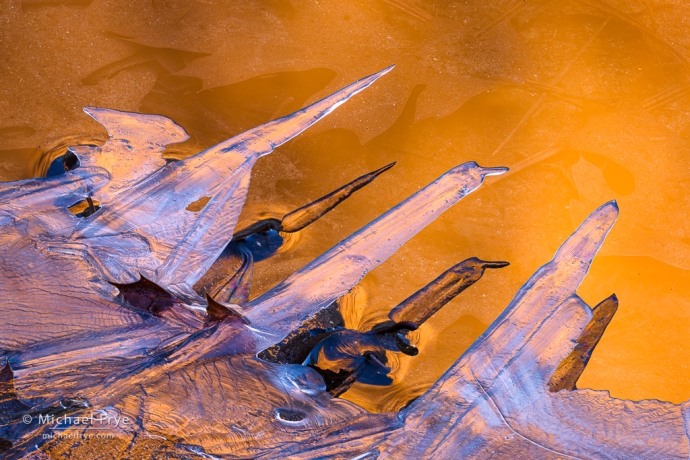
Ice fingers, Yosemite NP, California. 400mm, 1 second at f/16, ISO 100; 18 focus-stacked frames blended with Helicon Focus Pro. I needed to photograph this detail at an angle to get the orange reflections, requiring focus-stacking to get everything sharp. (It’s a reflection of a cliff lit by the setting sun.)
Last Thursday, Friday, and Saturday two smaller storms moved through the Sierra, bringing rain and higher-elevation snow. But for a couple of weeks before that it had been dry and warm – reaching the upper 60s at our house in Mariposa.
Early last week, as we were starting our workshop in Yosemite Valley, temperatures cooled off a bit, allowing ice to form along the banks of the Merced River. It’s always fun to photograph ice like this, with its beautiful patterns, designs, and colors. But it can be challenging, both technically and creatively.
(more…)
by Michael Frye | Nov 16, 2023 | Advanced Techniques, Vision and Creativity
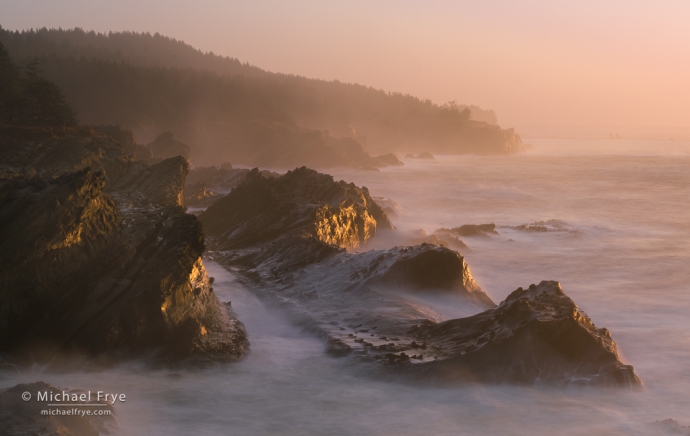
Misty sunset on the Oregon Coast. 73mm, 8 seconds at f/16, ISO 100, ND filter.
Claudia and I have been spending a lot of time in the Pacific Northwest this year, which is great, as I love this part of the world. We just finished a workshop along the Oregon Coast, and now we’re making our way to Bellingham, Washington, to visit our son and daughter-in-law, and stopping to see friends along the way.
The workshop was a lot of fun. A great group of people, and we saw some beautiful light, as well as big waves crashing against the shore.
(more…)
by Michael Frye | Feb 17, 2022 | Advanced Techniques, Vision and Creativity
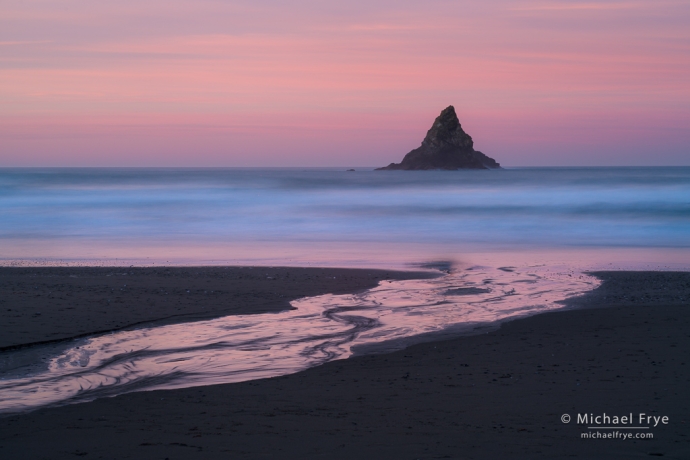
Creek and sea stack, sunrise, Oregon Coast. I used a slow shutter speed (30 seconds) to smooth the waves, which simplified the scene by eliminating texture in the water, and helped create a more ethereal quality to the image.
In one of my posts about Yellowstone last fall I talked about my attraction to dynamic landscapes. And Yellowstone is certainly dynamic, with its ever-changing array of spouting geysers and steaming vents.
But seascapes might be even more dynamic. In addition to the usual variables of landscape photography – light and weather – there’s the ocean itself. Tides, wave height, wave direction, and wind all have big effects on the way a scene looks. And no two waves are the same, so one moment will often look quite different from the next.
(more…)
by Michael Frye | Nov 8, 2020 | Advanced Techniques, Travels and Stories
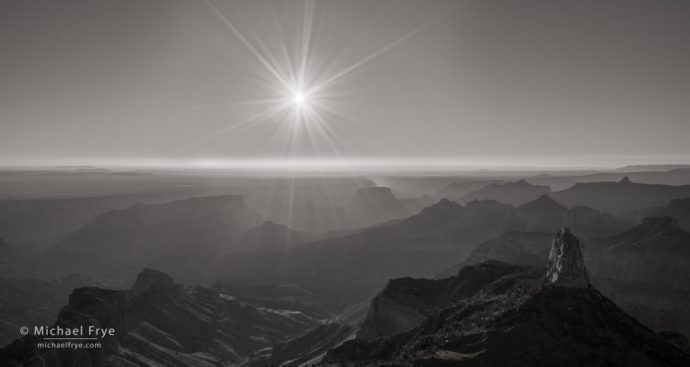
Morning sunlight from the North Rim of the Grand Canyon, Arizona. I used the “thumb technique” to reduce flare in this image; see the post for more details.
On our road trip last month Claudia and I found ourselves in Kanab, Utah. We cooked breakfast at a picnic table in a small park in town, and discussed our next move. There are a lot of options from Kanab. Should we head to Zion? Detour east toward the Paria River area? Drive the Cottonwood Canyon Road?
And then I thought, we’re pretty close to the North Rim of the Grand Canyon. And neither of us had ever been there. So the North Rim it was.
(more…)
by Michael Frye | Apr 20, 2020 | Advanced Techniques, Digital Photography Basics, Photography Tips
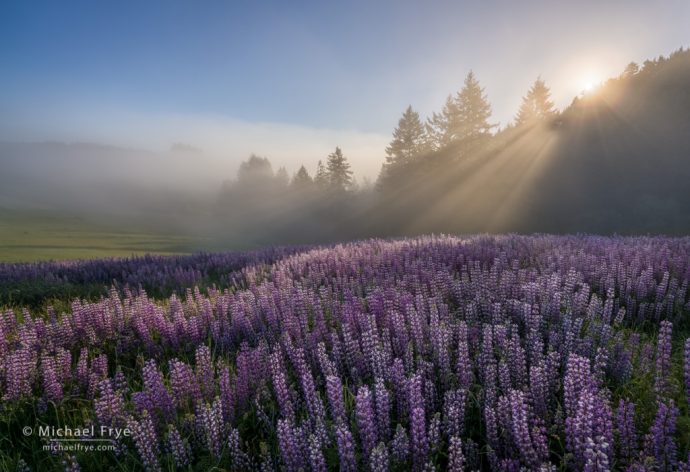
Sun rising over a field of lupines, Redwood NP, California. The focal length was 16mm, and the closest objects to the camera were the flowers at the very bottom of the frame, about two feet from the lens. I used my hyperfocal-distance shortcut to find the optimum focus distance, by doubling the distance from the closest object and focusing at four feet. Then I stopped to down to f/16 to get enough depth of field to make both the foreground and background sharp. 16mm, three bracketed exposures at f/16, ISO 100, blended with Lightroom’s HDR Merge.
In this recent post I talked about the importance of having a solid, well-practiced field routine, so that you don’t forget important steps, and you’ll be less likely to panic when the light gets interesting.
One of the steps in my routine, focusing, deserves a little more attention, so I’m going to cover that step in more detail here.
(more…)
by Michael Frye | Apr 12, 2020 | Advanced Techniques, Digital Photography Basics, Photography Tips
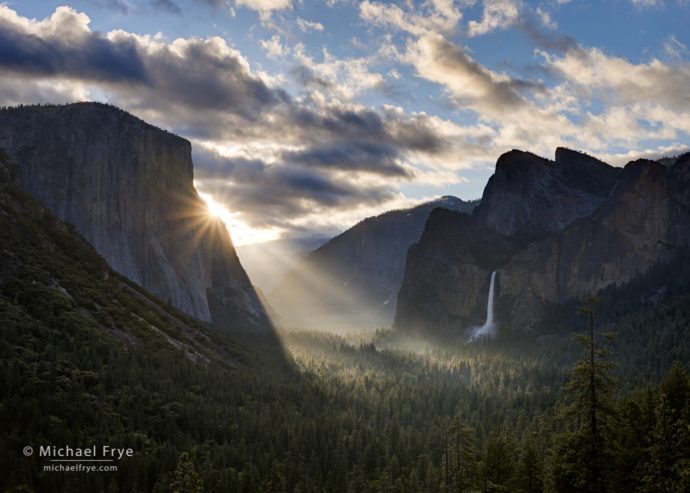
Sunbeams from Tunnel View, spring, Yosemite. Having a solid, well-practiced field routine helps me to calmly capture fleeting moments of light like this. 40mm, three auto-bracketed bracketed exposures at f/11, ISO 100.
Do you have a consistent field routine? Do you go through the same steps, in the same order, every time you take a photograph?
If you said no, you’re in good company. Most photographers I work with don’t have a solid, consistent field routine.
But I think having this routine is vital. Without one, you’re likely to forget important steps, like setting the right f-stop, or checking sharpness (and then kick yourself later when you realize your mistake). And when a rainbow suddenly appears over Yosemite Valley, or sunbeams break through the fog in a redwood forest, having a solid, consistent routine that you’ve practiced over and over will help you avoid panicking. You can just go through your normal routine and concentrate on putting one foot in front of the other, knowing that you won’t forget an important step.
(more…)














